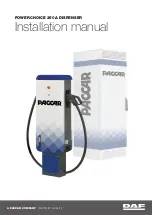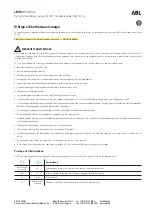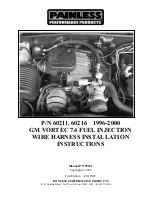
and multiplied by 1,000 is the RTI. This vehicle has an
RTI of 429 (connected sway bar) or an RTI of 538 (dis-
connected sway bar), which means you can articulate
one front wheel 22 inches (56 cm) or 27.5 inches
(70cm) in the air while the other three wheels remain in
contact with the ground.
Water Fording Characteristics
Water fording characteristic is the vehicle's ability to
cross a body of still water, where the powertrain and
drivetrain are safe from water ingestion. This vehicle
has high water fording characteristics with the ability to
cross a pool of water, without stopping, 24 inches
(60 cm) deep at a maximum speed of 10 mph
(16 km/h) and a pool of water 30 inches (76 cm) deep
at a maximum speed of 5 mph (8 km/h), both with an
entrance ramp angle of 1.3 degrees.
CAUTION!
The door sill height is 25 inches (63.5 cm). Water
may intrude into the interior of the vehicle at greater
depths.
Simultaneous Brake And Throttle
Operation
Many off-road driving conditions require the simultane-
ous use of the brake and throttle (two footed driving).
When climbing rocks, logs, or other stepped objects,
using light brake pressure with light throttle will keep
the vehicle from jerking or lurching. This technique is
also used when you need to stop and restart a vehicle
on a steep incline.
The Basics Of Off-Road Driving
You will encounter many types of terrain driving off-
road. You should be familiar with the terrain and area
before proceeding. There are many types of surface
conditions: hard packed dirt, gravel, rocks, grass, sand,
mud, snow and ice. Every surface has a different effect
on your vehicle's steering, handling and traction. Con-
trolling your vehicle is one of the keys to successful off-
road driving, so always keep a firm grip on the steering
wheel and maintain a good driving posture. Avoid sud-
den accelerations, turns or braking. In most cases there
are no road signs, posted speed limits or signal lights.
Therefore you will need to use your own good judgment
on what is safe and what isn't. When on a trail you
should always be looking ahead for surface obstacles
and changes in terrain. The key is to plan your future
driving route while remembering what you are currently
driving over.
WARNING!
Always wear your seat belt and firmly tie down cargo.
Unsecured cargo can become projectiles in an off-
road situation.
CAUTION!
Never park your vehicle over dry grass or other com-
bustible materials. The heat from your vehicle
exhaust system could cause a fire.
When To Use Low Range
When driving off-road, shift into 4WD LOW for additional
traction or to improve handling and control on slippery
or difficult terrain. Due to the lower gearing, low range
will allow the engine to operate in a higher power range.
This will allow you to idle over obstacles and down hills,
with improved control and less effort. Also, use 4WD
LOW in rain, ice, snow, mud, and sand to get heavy
loads rolling, improve traction, or whenever 4WD HIGH
traction will not do the job.
DRIVING IN SNOW, MUD AND SAND
There is a drastic reduction in traction when driving in
snow, mud or sand. The vehicle will be less responsive
to steering, acceleration and braking inputs. Therefore
you should accelerate slowly, leave greater stopping
distances and avoid abrupt vehicle maneuvers. You
want to keep a slow constant steady pace. The key is to
maintain the vehicle's momentum.
•
Snow
– In heavy snow or for additional control and
traction at slower speeds, shift the transmission to a
low gear and shift the transfer case to 4WD LOW if
necessary. Do not shift to a lower gear than necessary
to maintain headway. Over-revving the engine can spin
the wheels and traction will be lost. If you start to slow
to a stop, try turning your steering wheel no more than
a quarter turn quickly back and forth, while still apply-
ing throttle. This will allow the tires to get a fresh "bite"
and help maintain your momentum.
CAUTION!
On icy or slippery roads, do not downshift at high
engine RPMs or vehicle speeds because engine brak-
ing may cause skidding and loss of control.
192
STARTING AND OPERATING
















































